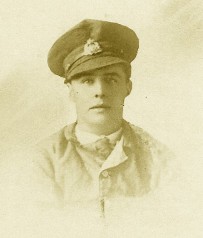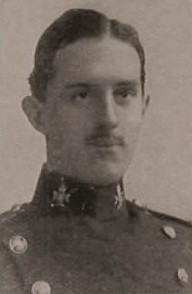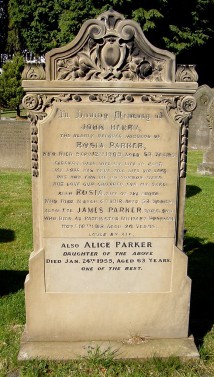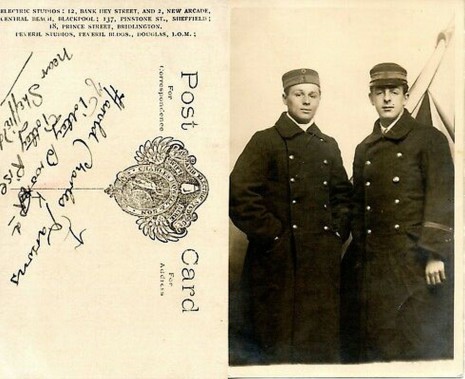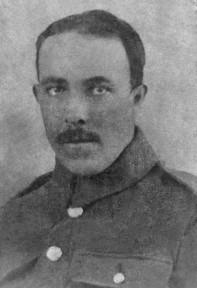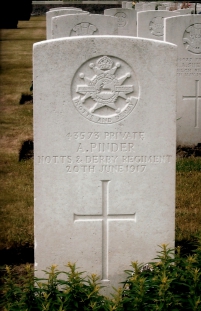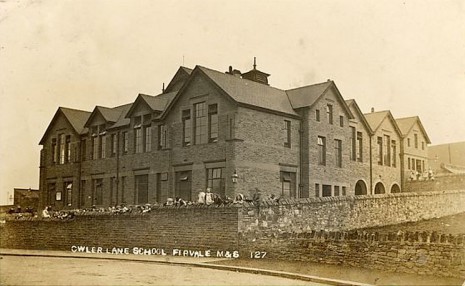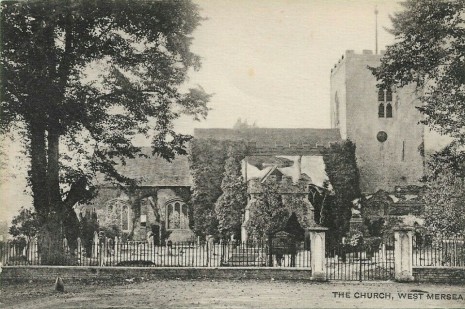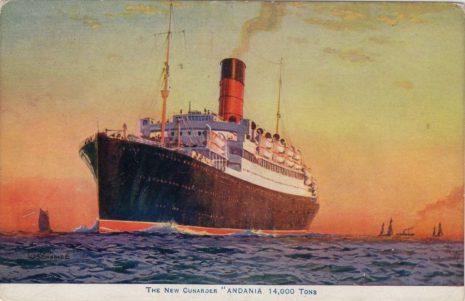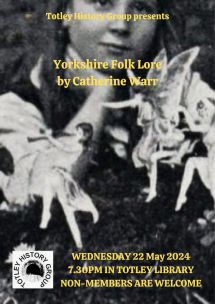WW1 Casualties L-R
Edwin Marsden
Edwin Marsden was born in Sheffield in 1887 and named after his paternal grandfather. He was the only son of Arthur Edwin Marsden and his wife Sarah, nee Tate, who had married at St. Mark's Parish Church, Broomhall on 19 July 1883. Edwin's older sister Ruth had been born in Sheffield on 18 January 1885.
Arthur Marsden was an carver and fluter in a family firm of ivory merchants to the cutlery trade which had been established in the 1850s by his uncle, William Marsden. By the early 1900s, the firm of Edwin Marsden & Sons of Aberdeen Works, 99 Division Street, Sheffield were well known at the ivory sales in London and Antwerp. Young Edwin was educated at St. Cuthbert's College, a boarding school for boys, at Sparken Hill, Workshop, Nottinghamshire. After leaving school he became a fitter serving an apprenticeship with Vickers.
On 21 May 1908 he enlisted in the 17th Field Company of the Royal Engineers and was stationed at The Curragh, County Kildare, Ireland where he was an instructor in bridge building. He invented an improvement on the Wheldon tressle which was accepted by the War Office and became known as the Marsden Band Tressle.
Edwin was sent to France when war broke out and arrived at the front near Mons on 17 August 1914. His war lasted only six days as he was killed in action on 23 August. Edwin had volunteered to blow up a bridge under heavy enemy fire which he did successfully returning unscathed. Shortly afterwards he looked over the parapet and was hit in the head by a shrapnel bullet killing him instantly. Edwin was mentioned in the dispatches of Sir John French for gallant and distinguished conduct in the field. He was aged 27 and unmarried. Second Corporal Edwin Marsden is buried in the Hautrage Military Cemetery, Hainaut, Belgium and is remembered on memorials at Hathersage Memorial Hall and Worksop College.
The Marsden family had lived at 51 Clarkegrove Road, Broomhall and 155 Cemetery Road, Sharrow before moving to Hathersage by 1901. They came back to Sheffield by 1916 living at 6 Kenwood Bank before moving to Stanmore, 206 Baslow Road, Totley. Ruth Marsden died in 1922, her father in 1931 and mother in 1938.
George Martin
George Martin was born in Totley on 27 August 1891, the eighth of ten children born to Samuel Martin, a railway tunnel miner, and his wife Jane, nee Beer who had married in Bristol in 1873.
The family were rarely in one place for long as they followed the development of the railway. This can be seen from the birth places of the children: Samuel junior (1876, Grimston, Leics.), William (1880, West Hoathly, Sussex), Alice Ada (1881, Oxted, Surrey), Elizabeth (1883, Whitchurch, Hants.), James (1884, Caldicot, Monmouth.), Caroline (1887, St. Nicholas, Glam.), Nellie (1889, Totley), George (1891, Totley), Florence (1895, Maulden, Beds.) and David Joseph (1897, Helidon, Northants.).
During their stay in Totley the family lived on Bricky Row and later at Green Oak as Lemont Road was then called. Two of the children died during the smallpox outbreak of 1893 and were buried in simply marked graves at Dore Christ Church: Lizzie on 24 April, age 10, and Alice two days later, aged 11. The six children who were of school age attended Totley Church School. George was too young, of course, and his first school was at High Lane, Marple, Cheshire which he attended between 21 August 1899 and 5 December 1901. But before then George's father had committed suicide at a navvy camp near Helidon on 4 May 1897. He had been employed by Thomas Oliver and Sons, who earlier built the Totley Tunnel, in the construction of a 2,997 yard tunnel at Catesby. He left about a hundred pounds, mostly in gold coin.
George's mother remarried in Marylebone, London on 11 April 1898 to George Clarke, a labourer from Athlone in Ireland. The family's nomadic life continued, however, as George's older brothers Samuel junior, Willie, and James all became tunnel miners like their father. The family had moved to Hebden Bridge by 1903 and then to Todmorden where George's mother died in 1910. In the census the following year only George, Florence, James and Joseph remained at home with their stepfather.
On 27 November 1915 George enlisted in the 1/7th Battalion of the Duke of Wellington's (West Riding) Regiment. He was mobilized on 6 August 1917 and posted overseas on 7 December 1917. Private George Martin was killed in action on 11 October 1918, aged 27. He is buried in the Wellington Cemetery in the village of Rieux-en-Cambrésis near Cambrai, France and is commemorated on the Todmorden war memorial.
Robert Hugh Martin
Robert Hugh Martin, known as Bob, was born in Walkley on 14 November 1896, the second son of Harry Martin and his wife Jeanetta (nee Biltcliffe). Bob and his siblings attended Burgoyne Road School. Cundy Street Chapel featured significantly in the lives of the Martin family.
Bob and his brothers Herbert and Victor were keen footballers, playing for Burgoyne Road School football club, Cundy Street football club and, later, Totley football club.
As a very young man Bob worked for Cole Brothers in Sheffield, travelling daily from Dore & Totley station. A 1910 photograph shows him and other employees on an annual outing. Bob was then apprenticed to Hartley & Son, printers, where his elder brother Herbert was also apprenticed, later becoming a master printer and bookbinder. The Hartley and Martin families were old friends. Ironically, in Malta in 1918, as Bob was being taken by stretcher, one of the bearers, a Totley boy, said, "It's a long way from Dore & Totley station, isn't it Bob?". He was a Parker, a relative of Mrs Flo. Hartley nee Parker.
In 1912 Harry and Jeanetta Martin, together with their children Herbert, Bob, Doris, Winifred, Victor and Lilian Wordsworth moved to Glenbourne, on Back Lane, Totley Rise. Jeanetta's aunt, Martha Hawes, nee Wordsworth, lived next door at Glenrose. Totley has strong associations for many of the Martin descendants to the present day.
WW1 saw many changes for many families and nothing would ever be the same for any of them. Herbert joined the Royal Engineers and served in France and Germany.
In 1914 Bob was a fine, strong young man of 17 who looked older than his years. As he was walking to the station one morning a passing woman held up a white feather, a traditional symbol of cowardice, especially at the start of The Great War. This action so upset him that instead of going to work Bob went to Gell Street to enlist even though he was under age.
He joined the Household Cavalry and Cavalry of the Line Regiment, Derbyshire Yeomanry Battalion, Service No. 75965, serving overseas.On 14 November 1917, Bob's 21st birthday, he was shot in Salonika, Greece. The bullet lodged in his heart but did not kill him. He rode his horse back to camp but, as there was no x-ray facility, he had to be taken to the island of Malta which had excellent medical equipment and facilities.
He left Salonika on the hospital ship HMHS Glenart Castle. On arrival in Malta he was taken to St Elmo Hospital, Valletta, where pioneering surgery was performed to remove the bullet. The
operation was reported in the Daily Malta Chronicle as being "the talk of the Island". The Glenart Castle was returning to Britain when it was torpedoed by German U-boat UC-56 on 26 February
1918 and it sank near Lundy Island with the loss of 162 lives.
Bob's operation was successful. The bullet was removed but he died of blood poisoning on 14 March 1918. He is buried in Grave Reference C. XVII. 4. in the WW1 Section of Pieta Military Cemetery, Malta.
Robert Hugh Martin, along with his fallen colleagues, is remembered on the Rolls of Honour in Totley Rise Methodist Church and Dore & Totley United Reformed Church.
James McPhee
James McPhee was born in Glasgow in 1887, the elder son of Hugh McPhee, a cabinet maker and furniture salesman and his wife Flora, nee White who had married in 1882. In the 1891 Census James was living with his parents and two older sisters, Marion and Mary, and younger sister Flora in Main Street, Gorbals, Lanarkshire. By the time of the 1901 census a younger brother Hugh and sister Eliza had joined the family who were now living at 3 Apsley Place, Gorbals. James, aged 14, had left school and become an office boy.
We know very little about James's military career except that he joined as a Private in the 2nd Battalion (17th Glasgow Pals) of the Highland Light Infantry and arrived in France on 12 November 1915. Whilst on leave, James married Annie Hibbard at King's Hall, Hull on 9 January 1918. Annie was one of eight children born to John William Hibbard, an etcher and guilder on cutlery, and his wife Mary Jane, nee Revitt who lived at South View, 118 Totley Brook Road.
James suffered a minor wound to the hand in March 1918 which required a 7 day stay the 18th General Hospital. After recovering from his wound James rejoined his Battalion in France. He was reported killed in action on 12 September 1918. He was aged 31. Private James McPhee is buried at the Vaulx Hill Cemetery at Vaulx-Vraucourt, Pas-de-Calais, France.
Roy Denzil Pashley Milner
Roy Milner was was born in Totley on 1 December 1892, the second son and youngest child of William Aldam Milner and Sarah Elizabeth Milner (nee Roberts), of Totley Hall.Roy's father was born in Wadsley, Yorkshire on 26 March 1854, the son of William Pashley Milner and Susan Aldam Aldam. He was a barrister and magistrate and in the 1881 census he lived with his parents at Meersbrook Hall, Norton. Roy's mother was born in Sheffield in 1857, the daughter of Sir Samuel Roberts, a Sheffield magistrate and MP, and his wife Sarah Ann (nee Sorby).
Roy's parents were married in Sheffield on 6 June 1883 and the following year they moved to Totley, altering the old hall and building the lodge on Totley Hall Lane in 1887. Their first child was a daughter, Marjorie Elsie, who was baptized at Christ Church, Dore on 21 June 1884. Two sons followed who were also baptized there, William Alfred (known as Billy) on 20 April 1888 and Roy Denzil Pashley on 1 April 1893.
Marjorie married William Wilson Jnr., a snuff manufacturer of Beauchief Hall, Norton, at Christ Church Dore on 1 July 1909 and went to live at Horsley Gate Hall, Holmsfield, Derbyshire. The Sharrow Mill snuff business still exists and is owned and run by members of the Wilson family. Roy's father was made High Sheriff of Derbyshire in March 1911. Both he and his wife were Governors of Totley All Saints School and Joan Stratford's history of the school chronicles many of Sarah Milner's visits to give talks, donations and prizes. The children also enjoyed visits to Totley Hall to see the gardens and she accompanied them on outings.
Roy Milner was a pupil at Repton School in south Derbyshire from September 1906 to July 1911. When he left school, he joined the Army and went to the Royal Military College Sandhurst for his initial training as an officer. He obtained a commission in the 2nd Battalion of the Sherwood Foresters (Notts and Derby Regiment) on 22 January 1913 and looked forward to a promising military career. He was very popular with his fellow officers and men and he played polo for his regiment when they were stationed at Plymouth. He was also fond of hunting and he was a member of the Barlow Hunt.
On the outbreak of war Sec. Lt. Milner, two other officers and a hundred men were deployed to South Shields where they took over a battleship that Armstrong, Whitworth & Company had built for Turkey but which was instead claimed by the British Government. The soldiers were on board for two days until the Royal Navy arrived to take possession of the ship. On 8 September 1914 the regiment sailed from Southampton and arrived at St. Nazaire in France on 11 September. They formed part of the 18th Brigade of the British Expeditionary Force. Roy wrote home to his parents to say that he was on his way to the front and was in good spirits.
On 14 September Sec. Lt Milner and his men of ‘A’ company began the 350 mile march to the area around the River Aisne in Picardy. The following day the battalion marched for fifteen hours in heavy rain. The drenching rain continued as they marched for another twelve hours on the 16th. Finally, weary and footsore, they arrived at Chacrise on the 18th where they were billeted on a farm and were given a 24 hour rest period. On 19 September with three other battalions of the 18th Brigade they moved forward to the village of Vendresse in the steep-sided Troyon valley where they relieved the 1st Black Watch in the trenches. Later that day they were moved back to a reserve line.
20 September dawned wet and cold with heavy rain and sleet falling. The Sherwood Foresters joined other regiments as they attempted, with some success, to retake trenches broken into and occupied by the Germans. Roy Milner, with a fellow officer and most of their men, was cut down by heavy machine gun fire as he led a charge up the valley. On 24 September Mr and Mrs Milner received a telegram from the War Office announcing the news of Roy's death. His body now lies in Grave Ref. 6. C. 5 in the Chauny Communal Cemetery British Extension in Aisne, France.
For the rest of the war Sarah Milner worked tirelessly helping to provide aid and comforts for wounded soldiers and also informing and educating local people about the conflict and how they could help the men at the Front. How difficult this must have been for her as she mourned the loss of her youngest child. After the war William and Sarah Milner gave land on Totley Hall Lane and money towards the building of a new church. All Saints Church opened in 1924 and the chancel is dedicated to Roy Milner.
Roy's father died in 1931 and his mother went to live in Titheacre, Baslow, Derbyshire shortly after and died aged 87 in 1944. The family name is commemorated in the names of roads built in Totley in the 1930s, the first of which was Aldam Road.
Ralph Norman
Ralf Norman was born in Totley on 13 May 1892 and baptised at Chedworth, Gloucestershire on 12 June in the same church where his parents, Cornelius Norman and Martha Keturah Beames had married on 20 June 1891. Ralph was the first of four children but, besides himself, only his brother Charles survived to adulthood.
The family appear to have followed Cornelius's sister Mary Ann who moved up from Gloucestershire to Totley after her marriage in 1890 to William Norman, a tunnel miner, who presumably worked on the Totley Tunnel. Both Norman families lived in the navvy huts at Green Oak where Ralph's cousin, John, was born in 1891.
Their stay in Totley was short with Cornelius and his family moving to Shirebrook by 1896 and Church Gresley by the time of the next census in 1901. From being a labourer, Cornelius had become a coal miner's sinker. Son Charles was born in Arley, Warwickshire, another coal mining town, and baptised at St. Andrew's, Chedworth on 27 August 1905. By the time of the next census in 1911, the Norman family of four were living at Balby, Doncaster. Ralph, aged 18, had become an electrician working for a colliery company. He was still an electrician on 17 March 1915 when he married Ada Alice Mattock at St. Peter's Church, Barnburgh, near Bolton upon Dearne. Ralph and Ada were living at Green Lane, Barnburgh when their son Ralph junior was born on 31 August 1915.
On 9 December that year Ralph senior enlisted at Mexborough in the territorial reserve of 9th Battalion of the Royal Welsh Fusiliers. He was mobilized on 8 December 1916 and served at home until 10 May 1917 when he was sent to France. Ralph was reported missing, presumed killed in action, on 22 March 1918. He was aged 25. Private Ralph Norman is commemorated on Bay 6 of the Arras Memorial, Pas de Calais, France and on the memorial tablet at St. Peter's Church, Barnburgh.
James Parker
James Parker was the third child of John Henry and Rosa Parker and was born on 8 June 1888, being baptized at Christ Church, Dore on 8 July that year. His grandfather, George, was born in Totley, but the family moved to Attercliffe soon after the birth of John Henry in 1857, where George was employed as a miner at Brightside Colliery, owned by Messrs Unwin and Shaw. The family in the 1861 census was George and his wife Sarah, with four children George junior (aged 8), Elizabeth (aged 7), John Henry (aged 5) and Frances Emma (aged 8 months), living at Bentley Houses, Whitworth's Lane, Attercliffe-cum-Darnall.
They were soon to suffer tragedy. Frances Emma died in 1864 and in 1865, when Sarah was heavily pregnant, there was a pit accident in which both George senior and their son George (aged 13) were killed. They had been working in the Parkgate seam of the colliery, not long opened. "At no time since it has been worked has there been the slightest indication of gas, and such has been the confidence of the workmen in their safety that naked lights have been freely used." This, despite the safety lamp having been invented in 1815.
It appears this was the cause of the firedamp explosion which instantly killed one man. At some distance along the seam George and his son were severely burned and had tried to escape but were overcome by the 'after damp' and nearly suffocated. Quickly rescued, they were conveyed home on a cart and attended by a surgeon, Mr Shaw. Initially it was hoped that George senior might survive, although the same hopes were not expressed for the boy's recovery. They both died two days later on 25 October. Within weeks Sarah gave birth to a son, whom she again named George, and returned to live with her parents in Totley. She opened a grocery store on Baslow Road which she ran until her death in 1903, living with George who at this time still a bachelor.
John Henry became a stonemason and married Rosa Taylor, from Dore, in 1883. They had 10 children over a period of 25 years, the last being born just a year before the death of John Henry at the age of 52 in 1909. Younger brother George was also a stonemason so may have carved the ornate border on his headstone. Rosa lived on in their cottage in Summer Lane with 8 of her children including James. In September 1916 she was admitted to Mickleover Asylum having had a nine month history of 'melancholia'. She never returned home and died from chronic nephritis in March 1918, aged 54.
Rosa used many forms of her name in documents over the years. There are at least five, and possibly six! In the 1891 census she was Rosanah but became Rose, Rosey and Rosa in future censuses and was finally recorded as Rosia at the time of her death in Mickleover Asylum near Derby in 1918. This is also the name on her memorial stone in Christ Church, Dore.
Jim was a pupil at Totley All Saints School, enrolling just before his third birthday in 1891 and leaving ten years later to begin work. He was recorded as a labourer in the 1911 census.
Initially Jim enlisted with the Lincolnshire regiment but was transferred to 507th Agricultural Company, Labour Corps. Was this because he had been injured? Unfortunately his service records have been lost.
The men of the Labour Corps were usually those not fit enough for front line duties and were occupied in preparing, supplying and clearing theatres of war. Early in WW1 these jobs were being performed by the fighting forces or local civilians, but as demands increased the Labour Corp was formed in 1917 to fulfill the demand. Amongst their duties were road and rail building and repair, moving of stores and ammunition, loading and unloading of ships and trains, and burying the dead. They were present in huge numbers in France and Flanders, often being drawn into the battle front and not always in armed units.
The Agricultural Companies were normally in England, the soldiers being of the lowest fitness level but providing labour on farms to help in the production of food. The 507th Company to which Jim was attached had its HQ in Beverley and he died aged 30 in Patrington Hospital near Spurn Point, where the Agricultural Company had a training camp. The cause of death, recorded by Capt. Morgan FRCS, was influenza, pneumonia and heart failure.
Jim Parker was a victim of the Spanish flu epidemic that would eventually claim more lives than those lost in the hostilities of WW1. His body was brought home and buried in the family grave in Dore Christ Church. His date of death was 10 November 1918, the eve of Armistice Day.
Harold Charles Parsons
was born in 1897 in Rhodes, Lancashire, the older of two sons born to Dr. Charles O'Connor Parsons and his wife Isabel Elizabeth, nee Kidman. Dr. Parsons was a physician and surgeon who came to live at Dovedale, 2 Totley Brook Road, when he bought a medical practice here in 1901. During the war he was in charge of the St. John's, Abbeydale VAD and Carter Knowle School hospitals, for which he was later awarded the M.B.E.
Harold enlisted in the 5th Battalion The King's Liverpool Regiment on 10 August 1915 but owing to his medical category he was transferred a few days later to the 43rd Provisional Battalion, a unit for men thought to be unfit for overseas service. On 15 January 1916 Harold was discharged from the army "in consequence of not being likely to become an efficient soldier" and transferred to the Merchant Service.
There he had many trying experiences, serving in various parts of the world. He was shipwrecked when aboard the SS Bornu but was rescued and taken to a French port. In later service his ship was torpedoed and he suffered other ordeals from which he contracted consumption.
After the war he had a severe breakdown which resulted in his death on 9 March 1920, aged 23. Harold Charles Parsons was buried at Christ Church, Dore three days later.
Albert Pinder
Albert Pinder was baptized at Christ Church, Dore on 11 March 1891, the son of Letitia (Letty) Pinder, single woman. Letty was the seventh of nine children born to John and Phoebe Pinder. Her father was a farm labourer at Moor Edge Farm, Totley when she was baptized on 17 April 1870. John Pinder died in March 1877 and two years later his 46 year old widow, Phoebe, remarried to the 25 year old Frederick Hassall.
Four years after the birth of her son, Albert, Letty married Robert Hodgson and they moved to Sutton in Ashfield leaving Albert to be brought up by his grandmother and her second husband. He was living with them in New Row (now called Summer Lane) Totley in 1891 aged 4 months whilst his mother works as a living-in domestic servant for Mr & Mrs Sydney Oxley at The Elms, Coal Aston.
In 1901 Albert and his cousin Harold Carr were both living with Phoebe and Frederick at Gleadless, Myrtle Hill where Frederick was working at his trade of brickburner.
Albert's great grandfather Robert Pinder and his wife Elizabeth had farmed a substantial area in Totley Bents, their home lying at what is now the junction of Penny Lane and Strawberry Lee Lane. His maternal great grandparents George and Hannah Elliott lived in the area around Hillfoot Road where George combined his trade as a stonemason with being a beerhouse keeper. Following George's death in 1859, Hannah kept the beerhouse going for many years.
Albert's grandmother Phoebe Hassall died in early March 1910 and was buried in Dore churchyard. Soon after this, Albert married Ella Maude Hill, the sister of Herbert Allan Hill, another of the men named on Totley War Memorial. In October 1910 their daughter was baptized at Christ Church, Dore, named Phoebe after Albert's recently deceased and much loved grandmother.
By the time of the 1911 census Albert, Ella and Phoebe were living at Moor View House on Butts Hill, Totley. Frederick Hassall must have been a good substitute father to Albert as he too was living with Albert and his young wife at Moor View House. Albert gave his occupation as 'cutler' on the 1911 census although at his daughter's baptism a few months earlier he was a postman. This seems much more likely as the village post office was just across the road from where he lived.
Albert's Army Service Record is among those that were destroyed during the Blitz in World War II so it is not possible to discover when he joined the Notts & Derby Regiment. He was probably among those conscripted during 1916 but he may have volunteered and been among the men of the 17th Battalion (Welbeck Rangers) who landed in France on 6 March 1916 and suffered heavy losses on the Somme.
By June 1917 the Welbeck Rangers were in the trenches which were very heavily shelled and on the 4th June the Battalion HQ was at St Jean and took several direct hits. Albert was probably wounded during the Battle of Messines Ridge which began on 7 June 1917. He died of his wounds on 20 June 1917 and is buried in Grave II.D.67 at Mendinghem Military Cemetery in Belgium. This cemetery was used for the dead from the 46th Casualty Clearing Station which is probably where Albert Pinder died.
In June 1917 Ella Pinder lost not only her husband but also her brother, Sgt Herbert Allan Hill. It is almost impossible to imagine the grief she must have felt at this double blow. There was eventually a happy ending for her though as after the War she married again and had several more children.
David Harry Prosser
Harry Prosser was born on 16 November 1898 in Heeley, the seventh of eight children born to Charles Albert Prosser and his wife Mary Elizabeth, nee Wright. Harry's father's career in the silver trade progressed from chaser, to fluter and eventually to silversmith.
As the family became more prosperous they moved further out of the city to Beauchief in 1903 and Holmesfield in 1911 before settling at Woodbine Cottage, (Queen) Victoria Road, Totley Rise soon after. Harry became a trainee school teacher.
He enlisted on 10 June 1916 in the 13th Battalion Training Reserve and, shortly after his 18th birthday, was mobilised on 25 November. He was promoted to lance corporal on 27 June 1917 and on 30 September 1917 he was discharged from the army on appointment to a commission with No. 1 Auxiliary School of Aerial Gunnery, at Hythe, Kent.
He joined the 27th Squadron R.A.F. as an observer. His aircraft was shot down and Harry was killed on 10 May 1918, aged 19. Second Lieutenant David Harry Prosser is buried at Caix New British Cemetery, Somme, France.
Alfred Riley was born in Sheffield in 1888. His mother was Mary Riley who was born in Sheffield on 30 July 1857, the youngest of five children of Matthew Riley, a labourer, and his wife Maria Mulligan, who were married around 1843 in Ireland, possibly at Delvin, County Westmeath, about 40 miles northwest of Dublin. Mary was unmarried and the name of Alfred's father was not recorded.
Alfred's grandparents came to England around 1850 bringing with them their two sons, Joseph born in 1844 and Michael born in 1849. In the 1851 census they were living in Court 3, Boden Lane, off Rockingham Street. Matthew Riley was a labourer but later became a blacksmith. Three more children were born before the next census, Edward in 1851, Matthew junior in 1854 and finally Alfred's mother Mary in 1857. She was baptised at the Roman Catholic Cathedral Church of St. Marie, Norfolk Row on 12 August 1857.
She was the last of their children as Mary's mother died of a miscarriage on 24 March 1860 when Mary was was aged just two. Her father remarried to Elizabeth Clunan in 1861 but Mary was brought up by her uncle Edward Mulligan, a tailor, and his wife Maria Smith who had married at Sheffield Parish Church (later Cathedral Church of St. Peter and St. Paul) on 30 August 1840. In 1861 they were living at 83 Carver Street with Maria's sister Elizabeth Smith, a grocer. Matthew Riley died on 17 March 1868 aged 47 and was buried at St. Michael's Roman Catholic Cemetery, Rivelin five days later.
Mary was still living with the Mulligans in 1871 at 15 St. Thomas Street in the Portobello district. Mary, aged 13, was a domestic servant. Edward Mulligan died in 1878 and was buried at Burngreave Cemetery on 29 September. Mary gave birth to a daughter, Florence, on 26 January 1880. She was unmarried and the father's name was not recorded. In the Census the next year Mary and Florence were at 24 Soho Street, Sharrow living with another aunt, Mary Ann Smith, who had married James Smith, an unrelated tool maker, on 2 February 1846 at Sheffield Parish Church.
Mary gave birth to a second daughter, Lilian, on 2 May 1882 at Ecclesall Bierlow Union Workhouse, Cherry Tree Hill. Again the father was not named. Lilian was adopted by a couple in Stockport, Cheshire when less than four years old. Alfred Riley was Mary's third child, born on 3 February 1888 at Brightside Bierlow Union Workhouse in Pitsmoor and again the father was not named.
On 8 October 1888 Mary Riley married widower Thomas Lenthall, a glass cutter, at Sheffield Parish Church. She was aged 31 and Thomas was aged 58. In the Census on 5 May 1891, Thomas and Mary were living at 5 Brook Lane, Netherthorpe with Florence, Alfred and Thomas's son James Albert from his first marriage. Robert Riley Lenthall, Mary's fourth child, was born on 9 May 1891. Thomas Lenthall died on 7 February 1893, aged 62. Mary and her stepson James then lived together as man and wife and had a son, Albert Cecil Lenthall, born on 30 December 1893. Their daughter, Mary Lilian Lenthall was born on 22 December 1895 but she died aged 1 on 17 October 1897 at 12 Court Upwell Street, Brightside and was buried at St Thomas Cemetery, Brightside on 21 October 1897.
Mary, James and the children then moved to Green Oak, Totley, although their stay in our area was a brief one. James was a file scourer and presumably the family's frequent house moves were in search of work. Alfred Riley had been admitted to the Infants Department of Brightside Nursery School on 7 July 1893 and continued his schooling at Owler Lane, Fir Vale before he joined Totley Church School on 7 July 1897. His half-brother Robert Riley Lenthall had also been at Owler Lane School before being admitted at Totley on 22 November 1897. Mary's seventh child, Ruth Elsie Lenthall, was born in Totley on 26 September 1898.
Mary's oldest daughter, Florence Riley, married Peter Rowney junior, a boiler maker's labourer, at Attercliffe Parish Church on 3 April 1899. Peter was born in Sheffield in 1867. They lived at 7 Frank Place where their first son Frank Joseph was born on 21 December 1899. By the 1901 Census they had moved to 288 Earlsham Road, Brightside where they would be joined the following month by James, Mary and her other children.
Soon afterwards however, Mary and James parted company. He married Sarah Lodge at St. Jude, Eldon Street on 13 October 1901 and went on to have six more children with her. Mary was then left with her four youngest children: Alfred aged 13, Robert aged 10, Cecil aged 7 and Ruth aged 3. On 27 October 1904 Alfred attested in Sheffield and became Private number 6863 in the 3rd Battalion of the West Yorkshire Regiment Militia. He gave his mother as his next of kin and her address as 30 Copster Road, Attercliffe. His civilian occupation was a pony driver. His brief military service record ends with "Deserted 21 July 1906" in red ink.
In fact Alfred had enlisted in the Durham Light Infantry, attesting in Sheffield on 11 October 1905. He stated quite clearly that he was a current member of the West Yorkshire Regiment Militia. It was a clear case of the left hand not knowing what right was doing. Alfred became Private number 9430 and was posted to Newcastle from 19 October until 28 November when he was sent to Cork in Ireland. He served there until 20 January 1909 when he was transferred to Jersey for almost two years, being promoted to Lance Corporal on 1 March 1909. On 19 January 1911 he was posted to Colchester and promoted to Corporal on 1 August 1911. Having served for 6 years 233 days with the Colours he was transferred to Army Reserve on 1 June 1912.
On 8 February 1913 Alfred married Daisy Beatrice English at Holy Trinity Church, Darnall. Daisy was born on 10 October 1894 at West Mersea, Essex the second of nine children of John English, a coastguard, and his wife Emily Jane Chapman who had married at the Church of St. Peter and St. Paul, West Mersea on 5 March 1892. Alfred and Daisy made their home at 105 Phillimore Road but eighteen months later war broke out and Alfred was called back to active service.
Alfred was mobilized on 5 August 1914 at Newcastle. He remained on the home front until 18 September and was then sent to France with the 2nd Battalion Durham Light Infantry embarking at Southampton. He was promoted to acting sergeant on 1 November 1914 which was confirmed on 7 April 1915. Alfred was trained as a machine gunner and he transferred to the Machine Gun Corps on 27 December 1915. For what appears to be a single act of drunkenness in an otherwise sober career he was demoted to the ranks on 27 October 1916 but soon worked his way back up to Corporal. Alfred was killed in action on 7 December 1917 during the Battle of Cambrai. He was aged 29. He is buried at Ribecourt British Cemetery, Nord, France and so far as we know he is not commemorated on any war memorial.
After Alfred's death, Daisy returned home to Essex to live with her mother at 79 Mersea Road, Colchester. She received Alfred's effects on 11 April 1918: a letter, photographs, wallet, cigarette case, gold ring, playing cards, disc and cap badge. Later she received three medals through the post on various dates: the 1914 Star, Victory Medal and British War Medal. She lived at the same address until 14 September 1922 when she embarked aboard the Cunard Line's Andania bound for Quebec. From there she made her way to Toronto to join up with her brother Victor. Daisy Riley remarried in Toronto on 29 March 1926 to Jack Edward Bates, a butcher from Blunham, Bedfordshire.
Alfred's half-brothers Robert and Cecil also served in the war and both survived. Robert was a Private with the 6th Battalion York and Lancaster Regiment and Cecil a Corporal with the 2nd Battalion King's Own Yorkshire Light Infantry. They were both awarded the Victory Medal and British War Medal. Cecil was also awarded the 1915 Star.
Search Our Website Here
Future Meetings
April
May
June
Unless stated otherwise our meetings are held in Totley Library on the 4th Wednesday of each month at 7.30pm.
Pauline Burnett's book The Rise of Totley Rise has been revised and updated. It tells the story of this small piece of land from 1875 when there was only a rolling mill and chemical yard alongside the river a mile from Totley, through Victorian and Edwardian times, two world wars and up to the present day. It has 94 pages including a useful index and many illustrations from private collections. The book is available now from Totley Rise Post Office priced at £5, or through our website when an additional charge will be made to cover packing and postage.
A few copies are still available of Sally Goldsmith's book Thirteen Acres: John Ruskin and the Totley Communists. Totley was the site of a utopian scheme funded by art critic and social reformer John Ruskin. In 1877 he bought 13-acre St. George’s Farm so that nine Sheffield working men and their families could work the land and, to keep themselves busy, make boots and shoes. Sally tells an engaging story from our history with a quirky cast of characters including Ruskin himself, the poet and gay rights activist Edward Carpenter and Henry Swan, a cycling, vegetarian artist and Quaker. The book is available to order online from the The Guild of St. George by following this link.
A recently discovered box of WWII correspondence reveals the story of how a small group of ladies from Dore and Totley recruited knitters from the west of Sheffield and how their efforts made them the country's greatest provider of Comforts for the Minesweeping crews of the Royal Navy. The story is told in Knit For Victory, a new book from Totley History Group. Written by Pauline Burnett, it has 82 pages and many illustrations. It is on sale in local shops and via our website. Further information about the correspondence is in this inside page of our website: Dore & Totley Minesweeping Trawlers Comforts Fund.
The story is told in Totley War Memorial WW1 of the ten men from our village who gave their lives in the Great War. Written by Pauline Burnett, Jim Martin and Dorothy Prosser, a chapter is devoted to each of the soldiers with a family tree followed by as much information as could be discovered about the men and their families. There is also information about their military careers and the actions in which they lost their lives. The book has 64 pages and is illustrated throughout with photographs of the men, their families and the houses where they lived.
Totley All Saints' Church Parish Magazines for the years 1985-2006 with notices of baptisms, marriages and funerals and accounts of spiritual, educational, charitable and social matters in the village. Scanned in full, including advertisements from local traders.
In 1893 during the building of the Totley Tunnel there was an outbreak of smallpox amongst the navvies which spread to some of the local population. 17 people were buried in communal graves in Dore Churchyard, 6 from "Green Oak" (Lemont Road). The severity of the outbreak was principally caused by overcrowding and insanitary conditions in lodging houses .
Kathleen Grayson was a 39 year old housewife when WW2 broke out. She volunteered for the ARP and became an ambulance driver. During an air raid on Sheffield in July 1941, and despite her own injuries, she managed to get a seriously injured casualty to hospital. For this she was awarded a commendation from King George VI. Together with her friend Hilda Duffy, Kathleen also assembled a team of knitters to provide essential warm clothing for the men serving on the minesweepers patrolling the North Sea.
We have recently bought at auction the WW2 memorabilia of Douglas Platts whose family home was at Hillside, 98 Queen Victoria Road. After the war Douglas returned to his civilian occupation working in the family scissors manufacturing business. He lived in our area for the rest of his life.
We are very grateful to Mrs Valerie Taylor of Dore for lending us the title deeds to Lower Bents Farmhouse which is reputed to be the oldest surviving building in the area with a proven history back to 1621. We have now scanned and transcribed the deeds which could be particularly interesting to anyone with a connection to the local Fisher, Dalton and Marshall Families.
Until 1844, when Dore Christ Church parish was created, Totley township was part of Dronfield parish. We have now transcribed the burial records for former Totley residents at St. John the Baptist, Dronfield for the period 1678-1870 and at St. Swithin, Holmesfield for the period 1766-1901.
Whilst researching the history of the Dalton Family we found it useful to transcribe a number of early Wills and Inventories. These and those of many other Totley, Dore and Holmesfield people dating from between 1594 and 1856 have now been added to our website.
St. Swithin's Church, Holmesfield pre-dates Dore Christ Church and was the place where many of the people from Totley worshipped and were baptised, married and buried. Read the inscriptions on more than 750 gravestones in the churchyard including those of Mr. and Mrs. William Aldam Milner of Totley Hall, Jessie Matilda Tyzack (nee Fisher) of Avenue Farm, and Rev. J. A. Kerfoot of St. John's, Abbeydale.
Thomas Youdan was a music hall proprietor and benefactor who was living at Grove House, Totley in 1867 when he sponsored the first football knockout competition in the world for The Youdan Cup.
The words Millhouses Cricket Club can be seen in the background of team photos which are likely to date from between 1905 and the early 1920s, very probably pre-war. They were lent to us by Garth Inman who can identify his great uncle, Cecil Inman, in some of the photos and would like to know when they were taken and, if possible, the names of others present. Please take a look to see whether you can put names to any of the faces.
Josiah Hibberd was seriously injured whilst working on the construction of the Totley Tunnel in 1892. He died on 9 May 1897 at the age of 38 having apparently spent most of previous five years in hospital.
Bradway House was built around 1832 by Henry Greaves, a farmer, together with two adjacent cottages. We have traced most of the occupants of the property from these early days up to the start of World War Two.
We have transcribed the baptisms records at St. John the Evangelist, Abbeydale from when the church was consecrated in 1876 until just after the start of World War 1. The records are arranged in alphabetical order based upon the child's name and show the date of baptism, the names of the parents, their home location and occupation.
Nick Kuhn bought an original 1920s poster which had this owners' blind stamp in one corner. The stamp almost certainly refers to a house named Wigmore that was built in the late 1920s or early 1930s. The first occupiers that we can trace are John Howarth Caine, a district mineral agent for the LNER, his wife Florence Jane (nee Prince) and daughter Doris Mary. The Caine family lived at Wigmore until 1936 by which time the house would have been known simply as 12 The Quandrant.
George Griffiths died on 13 December 1888 following an explosion during the sinking of number 3 airshaft at Totley Bents. His widow Florence died shortly afterwards and his two daughters Maud and Annie were adopted separately. Whilst Annie lived the rest of her life in Yorkshire, Maud emigrated to Australia in 1923 with her husband, John Burrows, daughter Margaret and son Jack, pictured above.
George Wainwright was said to have been born in Bamford, Derbyshire in 1714. He learned the trade of linen weaving and moved to Totley after his marriage on 1744. He became an ardent follower of John Wesley who paid many visits to Sheffield and who would have passed through or close to Totley. Preaching was at first conducted out of doors and when Wesley's preachers became harassed by a mob of Totley ruffians in 1760, George offered them safety of his own home. He remained a Methodist for all of his long life, dying in Dore in 1821 at the reputed age of 107.
Oakwood School was started by Mrs Phoebe Holroyd in 1925 initially as the Firth Park Kindergarten and, by 1927, as the Firth Park Preparatory School. Phoebe was still working at the school almost fifty years later when she was well into her seventies. We would like to hear from anyone with memories of the school.
James Curtis was born at sea aboard HMS Chichester in 1790. He enlisted as a Private in the 1st Grenadier Regiment of Foot Guards in Sheffield in 1812 and served in Spain and Portugal during the Peninsular War. He later fought in France and Belgium taking part in the Battle of Waterloo. In later life James lived at the Cricket Inn where his son-in-law William Anthony was the licensed victualler. He died in Heeley in 1882 aged about 91.
Charles Paul lived in Totley in later life. He was a local historian and archaeologist who was an authority on the history of Sheffield, especially the two areas he knew best: Attercliffe and Ecclesall. His books and letters to local newspapers were published under the Latin form of his name Carolus Paulus.
Towards the end of the 19th century Totley Hall gardens became a well known beauty spot that attracted many hundreds of visitors from Sheffield on open days and the rock gardens became one of its most popular features. Mrs Annie Charlesworth sent us six glass transparencies of the rock gardens taken, we believe, in the early years following the Great War.
Anton Rodgers send us photographs of three water-colours that had been bought by his grandfather at a sale of the contents of Abbeydale Hall in 1919. One was of a scene said to be in York by A. Wilson. A second was of a seated child with a dog believed to be pianted by Juliana Russell (1841-1898). The third was of Lake Como, by Ainslie Hodson Bean (1851-1918) who lived for much of his life on the Riviera and in North Italy.
A Canadian correspondent sent us photographs of a set of silver spoons that were bought in a small town in British Columbia. The case contained a note signed by Ebenezer Hall indicating that they were a wedding gift to Maurice and Fanny Housley. We think we may have traced how they got to Canada and where they might have been since.
Green Oak Park was opened on 23 March 1929 on land that had been bought by Norton District Council from John Thomas Carr, a farmer and smallholder of Mona Villas. In later years, the buildings were used by the Bowling Club (the green having been built in 1956) and by the park keeper. However, the buildings appear to have been constructed in several phases, the oldest of which predates the park to the time when the land was used for pasture.
We believe the old Totley Police Station at 331 Baslow Road was built around 1882. Two lock-up cells were excavated just below floor level in the summer of 1890. We have traced the Derbyshire Constabulary police officers who lived there from John Burford in 1886 to George Thomas Wood who was there when Totley was absorbed into Sheffield in 1934.
David Stanley lived in Totley Rise in the later years of his life. Born in Bulwell, Nottinghamshire, he joined the 17th Lancers when he was 19 and rode in the Charge of The Light Brigade at the Battle of Balaclava where he was seriously wounded. For the first reunion of veterans in 1875, he told his story to a reporter from the Buxton Herald.
This picture postcard was addressed to Miss Abell, Holly Dene, Totley Brook Road and posted in Rotherham on 10 December 1907. Edith Annie Abell was born on 4 February 1887 in Sheffield and her family came to live in our area in the 1900s, staying for the rest of their lives.
Charles Herbert Nunn enlisted in the British Army on 23 August 1915 and was sent to France on 18 December 1915 to served with the British Expeditionary Force. In March 1916 it was discovered that he was underage and he was returned home. Shortly after his 18th birthday he re-enlisted and was again posted abroad where, in addition to this trio of medals, he was awarded the Military Medal.
This certificate was awarded jointly by the Red Cross and St. John's Ambulance to Isaac Henry Williams, of Lemont Road, for his services during WW1 as a stretcher bearer. We are seeking anyone who can help us pass it on to a living relative.
In 1832 Samuel Dean pleaded guilty to stealing a quantity of lead from the Totley Rolling Mill and was sentenced to seven years transportation to Australia. He sailed on the Mangles and upon arrival in New South Wales he was sent to work for William Cox, the famous English explorer and pioneer. After receiving his Certificate of Freedom in 1840, Samuel became a farmer and went on to have a very large family. Samuel was born in Whitechapel around 1811 to parents Samuel Dean Snr. and Susannah Duck. His descendant Sarah Dean would like help in tracing his ancestry.
Ellen Topham was born in 1889 in Nottingham. Her parents had been living together since 1862 but had never married so it was most unusual that, after their deaths, Ellen was accepted into Cherrytree Orphanage. Even more so since her father, Snowden Topham, had been acquitted somewhat unexpectedly in a widely reported manslaughter trial. Ellen remained at Cherrytree until her death from pulmonary tuberculosis at the age of 15.
Mabel Wilkes was a resident in Cherrytree Orphanage between 1897 and 1905. Her granddaughter Sally Knights sent us these images of a book presented to Mabel as a prize for her writing. Sally also sent us some personal memories of her grandmother and a photograph of a locket which contains portraits of Mabel and her husband Septimus Gale.
John Henry Manby Keighley was living at Avenue Farm when he enlisted in 1916. He fought in France with the Cheshire Regiment but after home leave in early 1918 he went missing. The Army were unable to determine whether he had deserted or returned to the front and been either killed or captured by the enemy. In August 1919 he was formally presumed killed in action but it appears he did not die but returned home to his family.
Horace Ford was admitted to Cherrytree Orphanage on 26 October 1888 at the age of six. He left at the age of 14 to become an apprentice blacksmith and farrier. Soon after his 18th birthday Horace enlisted in the Imperial Yeomanry to serve his country in the war in South Africa. His letter home to his Orphanage mentor tells of the lucky escape he had in battle.
Pat Skidmore (née Sampy) lived on Totley Brook Road from 1932 to 1948 before her family moved to Main Avenue. In this short article she remembers her time at Totley All Saints School where she was a contemporary of Eric Renshaw and Bob Carr.
As we have nowhere to exhibit memorabilia and artifacts, we have created a Virtual Museum instead. The latest addition to our collection is this double-sided Totley Rise Post Office oval illuminated sign which was on the wall of 67 Baslow Road before the Post Office business transferred to number 71. Please contact us by email if you have things that you own and would like to see added to the virtual museum.
Conway Plumbe was a man of many talents who came to live in Totley Rise around 1912. As a young man he had poems published by Punch magazine and is remembered in modern collections of WW1 poetry. A number of his paintings were accepted by the Royal Academy. An engineering graduate of London University, he joined the Civil Service where he rose to a high level as a factory inspector, publishing two books on the subject and giving a series of talks on workplace health and safety on BBC radio during WW2. In retirement he wrote a philosophical-spiritual work called Release From Time.
Inside Totley Rise Methodist Church there is a Roll of Honour commemorating the soldiers from its congregation who served their king and country during the Great War. For all but one of the 28 names the soldier's regiment is recorded in the next column. The exception is David Cockshott for whom 'killed in action' is written alongside yet he appears on no war memorial in our area and no record of a mortally wounded soldier of that name is to be found. We think we have solved the mystery.
Mrs. Kate Plumbe moved from Mansfield to Totley Rise with a number of her family in 1913 and became closely involved with the Totley Union Church. Her daughter Winifred became a missionary and headmistress in Calcutta for over 38 years following which she returned home to live with her sister Hilda on Furniss Avenue. Hilda had also been a teacher, missionary and, like her mother, a volunteer at St. John's VAD during WW1.
Thomas Glossop was a cutler and razor manufacturer who was well known amongst cricketing and gardening circles. Despite going blind, he was able to continue his hobbies with remarkable success
The Totley Union Cycling Society Prize Giving and Fete was held on the fields near Abbeydale Hall on 18 July 1914. Anne Rafferty and Gordon Wainwright have named some of the people in two wonderful photographs of the event. Can you identify any more for us?
The Tyzack family are well known in our area for owning iron and steel trades at Walk Mill, Abbeydale Works, Totley Rolling Mill and Totley Forge. This article covers the history of the family from the late 18th century when William Tyzack the founder of the company was born until the early 20th century when Joshua Tyzack farmed at Avenue Farm, Dore.
Walter Waller Marrison moved to Totley around 1897 with his wife and their two young sons. He was a house builder who constructed properties around Totley Brook and Greenoak before ill health forced him to take up less physically demanding work. In 1904 he took over the tenancy of the grocers and off licence at number 71 Baslow Road. After his death in 1908, his widow Kate and later their eldest son Jack continued to run the business until it was sold in 1934.
Ron Wijk of Nieuw-Vennep in the Netherlands has sent us two scanned images of drawings of old cottages made by the celebrated Dutch painter, Anton Pieck (1895-1987) simply annotated "Totley", and wondered whether we could identify their locations.
We would like to thank Christopher Rodgers for bringing to our attention this fascinating log of the 85th Sheffield (St. John's and Totley Orphanage) Wolf Cub Pack for 1927-45. The log is published jointly by Sheffield Scout Archives and Totley History Group as a free PDF download. It is illustrated by no fewer than 92 photographs and is supported by a comprehensive index and biographies of some of the main participants.
Following our Open Meeting event on School Days, Roger Hart, Howard Adams and John Timperley have each written to us with their memories of Norwood School, which was located in the rooms attached to the Dore & Totley United Reformed Church on Totley Brook Road.
On 22nd July 1909 the children of Dore and Totley Schools celebrated by a pageant the union of England under King Ecgbert which took place at Dore in AD 827. The pageant was devised and written by Mrs Sarah Milner and her daughter Marjorie and performed in a field close to Avenue Farm in front of a large audience. Photographs of the event survive together with a fragment of the script.
John Edward Greenwood Pinder had lived all 46 years of his life in Totley but on census night, Sunday 2 April 1911, he was not at home; he was in Derby Gaol serving a sentence of three months hard labour. From the age of 20, John had been in and out of local courts for a series of minor offences including drunkenness, assault, wilful damage and night poaching. Finally he was sent to gaol for cutting down and stealing 86 small trees which he sold in Sheffield market for Christmas.
We have already transcribed the census returns for Totley, Totley Rise and Dore. Now we have transcribed Census Strays. These are people who were born in Totley but are missing from our earlier transcriptions. They may have been living, working or studying elsewhere or just away from home on the night the census was taken. Two people were in prison. Others were in Union Workhouses, hospitals and asylums. Fully indexed strays from the 1851, 1861, 1881, 1891, 1901 and 1911 censuses are available now.
We wish to thank Gillian Walker for allowing us to digitize an archive of material about the 1st Totley Scout Group. Most of the material was collected by Arthur Percival Birley in the period 1949-51 and there are many interesting documents pertaining to the building of the scout hut on Totley Hall Lane. In addition four Newsletters survive, two from the 1940s and two from 1971.
We are grateful to Angela Waite and All Saints' Parish Church for giving us access to baptismal and kindergarten birthday rolls dating from 1926 to 1941. We have transcribed the names, addresses, birthdates and baptismal dates and created an alphabetical index of entries for you to search.
Edmund Sanderson, a Sheffield estate agent, aquired the land on either side of the old drive to Totley Grove in 1874 and divided it into plots for development. He called it the Totley Brook Estate. But before many houses were built, the estate road was severed in two by the building of the Dore & Chinley Railway line. The eastern end of the road became the cul-de-sac we now call Grove Road.
John Roberts was born in Sheffield in 1798. He became a partner in one of the leading silversmiths firms in the city before moving to Abbeydale Park in 1851 and extending the house in Victorian gothic style. He paid for the building of St. John's Church and was believed to dispense more in charity than any other person in the neighbourhood including his protege Ebenezer Hall.
The Coke Family owned the Totley Hall Estate from 1791 to 1881. With the aid of a family tree to guide us, Josie Dunsmore takes us through the story of their tenure.
When the Rev. D'Ewes Coke inherited the Totley Hall Estate in 1791 it had two farms. Josie Dunsmore tells the story of how the two farms were combined under the tenancy of Peter Flint with the aid of field maps drawn by Flint himself and later by the Fairbanks family.
Do you think you recognize this face? More than sixty photographs of the girls and teachers at Hurlfield Grammar School for Girls in the 1940s were given to Totley History Group by Avril Critchley, who was herself a student at the school. The collection includes fifteen form photographs from June 1949. There would have been a number of girls from the Totley area attending the school in those days.
Christine Weaving tells the story of her 2 x great uncle George Edward Hukin, a Totley razor-grinder, and his life-long friendship with the academic, poet, writer, and free-thinker Edward Carpenter.
Eric Renshaw (pictured here on the right with Bob Carr) grew up and lived in Totley from 1932 to 1960. Many of his memories are of a sporting nature.
We are very grateful to Gordon Grayson for giving us this splendid sale document for the Norton Hall Estates, following the death in 1850 of Samuel Shore. The estates included a large part of Totley and the document has maps and illustrations, plus schedules of land and property with the names of tenants. We have also added a transcription of the entries for Totley and Dore.
Watch this Youtube video of the talk given by Dr. Mark Frost and Sally Goldsmith on Ruskin, Totley and St. George's Farm. The talk was hosted by Totley History Group on 20th May 2015 as part of the Ruskin in Sheffield programme. Also enjoy a video of the outdoor performance Boots, Fresh Air & Ginger Beer written by Sally.
When Jacqueline A. Gibbons became interested in what made her father tick, it began a journey through WW1 archive records and led to her flying from Toronto to visit the house and village where he lived and the countryside that he so much enjoyed. Jacqueline reminds us that in the early 20th century Sheffield was a driving force of industry and that Totley was the place where many of its remarkable people lived and where they formulated their ideas.
Edgar Wood was the designer of The Dingle, 172 Prospect Road, built in 1904 for Rev. William Blackshaw, the founder of the Croft House Settlement. The house, together with its western terrace and boundary walls, has now been awarded Grade II listed building status.
What was probably "the most perfect little garden railway in existence" in 1910 was to be found in the grounds of Brook House, Grove Road, the home of its designer and constructor, Guy Mitchell. Look at some wonderful photographs and read reports in newspapers and a full appreciation in Model Railways magazine.
We have now completed our transcription of Totley School's Admission Records for the period from 1877 to 1914. There is also a useful index to the names of the scholars and to their parents or guardians. We are very grateful to Sheffield Archives and Local Studies Library for allowing us to transcribe and publish these records and for permission to reproduce the photograph of a specimen page of the register.
On 8, 9 and 11 November 2014 Totley History Group held an exhibition at Dore & Totley United Reformed Church to commemorate the centenary of the First World War. Below are additional links to some of the photographs we were lent and stories we researched especially for the exhibition.
Oscar Creswick was a local farmer who served with the Army Service Corps in Salonika and who after the war returned to Totley to become the innkeeper of the Cricket Inn and a member of the village's successful tug of war team.
Walter Evans was a market gardener who also ran a small grocery shop on Hillfoot Road when war broke out. He fought with the Machine Gun Corps at the fourth battle of Ypres. After the war, Walter ran a grocers shop at the top of Main Avenue.
Fred Cartwright was another Totley soldier who survived the Great War. He fought in France and Belgium and although he wasn't wounded he was gassed and was home on sick leave when his daughter was delivered by Nurse Jessop during a snowstorm in January 1917.
Maurice Johnson joined the Yorkshire Dragoons, a territorial unit, on 1 Jan 1914 and so was called up at the very start of the war. He fought throughout the war on the Somme, at Ypres and at Cambrai. After demobilization in 1919 Maurice returned to his old occupation in the steel industry.
Bill Glossop lent us a letter written by his father, William Walton Glossop to his wife describing life in the army during training in the north east of England and asking her to keep him in mind with the children.
The photo above provides a link to an album of photographs taken of WW1 Hospitals at St. John's, Abbeydale and the Longshaw Estate.
Nora Green, of Chapel Lane, was only 14 when war broke out. In 1914 she was ill with diphtheria and was sent to the isolation hospital at Holmley Lane, Dronfield. Nora recovered and wrote a letter of thanks to one of the hospital staff and the reply she received survives.
We have collected together on this page the names of local men who appear on various War Memorials and Rolls of Honour in Totley, Dore, Abbeydale, Norton, Holmesfield and Dronfield.
Unfortunately we were unable to identify all the photographs we were lent of Totley Soldiers. Please take a look at this album to see if you recognize any of the missing names.
This walk visits locations that have strong associations with Totley during the First World War. It includes the homes of the ten soldiers from the village who lost their lives, the auxiliary hospitals, war memorials, and even the rifle range on which the soldiers trained. Take a look at the first draft of a new walk by the authors of "Totley War Memorial WW1 1914-1918"
We wish to thank the Trustees of Cherrytree for giving us permission to publish transcriptions of the Cherrytree Orphanage Admissions Book entries for the years 1866-1929. There is also an alphabetical index for you to look at.
With more people having access to faster broadband and mobile networks, we have uploaded seven full and unedited oral history recordings and also added more short excerpts for you to listen to.
Our transcriptions of local trade directories have been expanded to cover the 95 years from 1837-1932 and have also been indexed. From the days when there were a handful of farmers, stone masons, saw handle makers & scythe grinders to the wonders of the Totley Bridge Garage Company, Betty's Boudoir and The Heatherfield Shopping Centre.
We continue to add to our Totley Newspaper Archive. Recent entries have included several about The Plumbe Family, Thomas Glossop and accidents during the construction of Totley Tunnel.
Totley Church of England Parish Magazines for the years 1922-1939 and 1948-1967 with notices of births, marriages and deaths and accounts of spiritual, educational, charitable and social matters in the village.
Around 90 photographs taken by Stuart Greenhoff for his thesis A Geographical Study of Dore and Totley including several of Totley Moor Brickworks. Superb!
Chronologically ordered snippets of information recorded by Brian Edwards during his many years of research into our local history.
Read the inscriptions on more than 700 gravestones in the churchyard.
Visitors since 24 Sep 2012:


